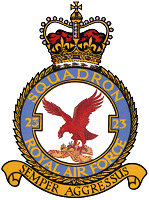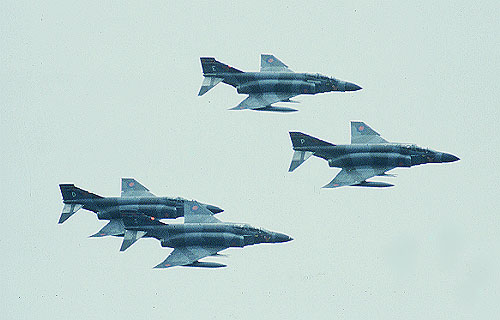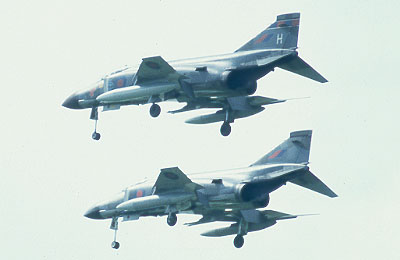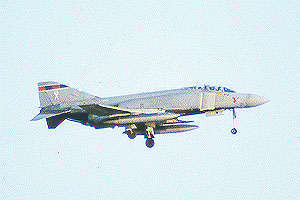Home | Airshows | The Hangar | Nostalgia | Links
Wattisham Squadrons
23 Squadron: 'Semper Aggressus' by Dave Eade
 There are a few squadrons in the RAF that qualify as
premier; the early fighter units that can trace their history through
the two wars, by definition, have flying histories that map the development
of British flying fighting machines. One such is 23 Squadron, today providing
the eyes and ears of the service with a fleet of Sentry AEW aircraft,
which can look back to Gosport and 1 September 1915 for its birth.
There are a few squadrons in the RAF that qualify as
premier; the early fighter units that can trace their history through
the two wars, by definition, have flying histories that map the development
of British flying fighting machines. One such is 23 Squadron, today providing
the eyes and ears of the service with a fleet of Sentry AEW aircraft,
which can look back to Gosport and 1 September 1915 for its birth.
Soon over the Channel 'in the thick of it', 23 was on the Western Front in March 1916, when commanded by Major R. E. T. Hogg, they were equipped with the venerable FE2b - the then AWACS of the RFC carrying out reconnaissance. Spad 7s followed, with some success, and the Sopwith Dolphin. It was with this aircraft that the unit were to come across the redoubtable Hauptmann Goering for the first time then in command of the infamous Richtofen circus.
 The end of the war saw disbandment for the first time
to rise again, with Sopwith Snipe fighters in 1929. The Gamecock followed,
and it was while equipped with this fighter that a certain P/O Douglas
Bader was posted to the squadron. While practising for the RAF display
to be held at Hendon, Bader crashed, severely damaging both legs, while
flying the newly acquired Bristol Bulldog. The rest, as we say, is history.
The end of the war saw disbandment for the first time
to rise again, with Sopwith Snipe fighters in 1929. The Gamecock followed,
and it was while equipped with this fighter that a certain P/O Douglas
Bader was posted to the squadron. While practising for the RAF display
to be held at Hendon, Bader crashed, severely damaging both legs, while
flying the newly acquired Bristol Bulldog. The rest, as we say, is history.
The role of a night fighter squadron came to 23, equipped with the Bristol Blenheim, as re-armament preceded the outbreak of hostilities in Europe. Shipping protection was the prime role, with Douglas Havocs and Bostons as time went on until finally the redoubtable Mosquito came their way. The unit left for sunnier climes one at the same time, moving to Malta from Little Snoring in Norfolk.
Disbandment again came in 1945 at the end of the war, only to reform, a year later, back in East Anglia again with Mosquitoes, although this time with the much improved NF30. From Wittering the unit moved to Coltishall gaining Mk 36 aircraft at the same time.
Progress overtook the Mosquito, as Coltishall re-equipped its night fighter unit with Vampire, then Venom jets, but it was with the Javelin that the RAF finally had a truly all weather/night/day fighter. With first the Mk 4 and then the Mk 9, with its in-flight refuelling capability, the squadron was at the forefront of this nations defence fleet. However, in March 1963, 23 (Javelin) Squadron vacated Coltishall and 23 (Lightning) Squadron reformed at Leuchars, in Fife.
 Most of the gremlins had been ironed out
of the Lightning interceptor, by the time that the F3 and 23 Squadron
joined forces becoming the first RAF unit to fly this mark. Although
to re-equip with the F6 in 1969, the squadrons association with the Lightning
was quite short, as disbandment and a move back to East Anglia was on
the cards.
Most of the gremlins had been ironed out
of the Lightning interceptor, by the time that the F3 and 23 Squadron
joined forces becoming the first RAF unit to fly this mark. Although
to re-equip with the F6 in 1969, the squadrons association with the Lightning
was quite short, as disbandment and a move back to East Anglia was on
the cards.
On 25 February 1976, with the McDonnell Douglas Phantom FGR2 as the squadron mount, the unit moved to Wattisham, in Suffolk, alongside the red/white chequerboard of 56 Squadron. For seven years the squadron shared the QRA role for the UK Southern sector with the 'Firebirds'. Regular diversions to Deci and Cyprus kept the average Phantom jockey from getting too bored (I wish!), and competition between the squadrons was rife. Living only a few miles form the airfield, your author was privileged to meet quite a few of the aircrew from the squadron, who took benefit of a house-price boom at the time, and purchased properties in villages around the airfield. Local hostelries were frequented and became their locals too, e.g. The 'Live and Let Live' at Combs. It always amazed us that called ourselves their friends, how bad their aim was with a dart no radar I suppose! (Willy, Rich, Wolfy if you are out there Dave says Hi).
 Ideas of ownership of real
estate in the South Atlantic were to upset the relative tranquillity of
23 Squadron life in 1985. The re-capture of the Falkland Islands meant
that we would have to permanently defend that area, in the future, and
the first aircraft to be sent were from 29 Squadron, but on 30 March 1983
the detachment changed to 23 and the Wattisham unit was run-down. So began
the still-used method of detaching crews for a three-month stint to these
unfriendly climes, for a taste of Penguin hospitality. Crews returning
spoke often of the penguins of the Falklands who were certainly taken
aback by these new giant LOUD birds of the southern skies.
Ideas of ownership of real
estate in the South Atlantic were to upset the relative tranquillity of
23 Squadron life in 1985. The re-capture of the Falkland Islands meant
that we would have to permanently defend that area, in the future, and
the first aircraft to be sent were from 29 Squadron, but on 30 March 1983
the detachment changed to 23 and the Wattisham unit was run-down. So began
the still-used method of detaching crews for a three-month stint to these
unfriendly climes, for a taste of Penguin hospitality. Crews returning
spoke often of the penguins of the Falklands who were certainly taken
aback by these new giant LOUD birds of the southern skies.
Eventually, as the perceived threat reduced, the air defence unit based on the Falkland Island was reduced to flight level, and the title of 23 Squadron passed to the Tornado F3 unit forming at Leeming in 1988. Participating in the Gulf War, it was somewhat surprising that a squadron with such a history should be discarded, but disbandment came again on 28 February 1994 as the Cold War thawed, and the F3 force was reduced.
The decision to form a second squadron in the Sentry AEW force at Waddington raised the squadron standard once more. It is here today that, tasked with the training of AWACS crews, you will find 23 Squadron steeped in history at the forefront, as always, of the defence of the UK.
Home | Airshows | The Hangar | Nostalgia | Links